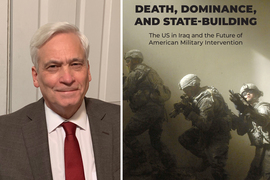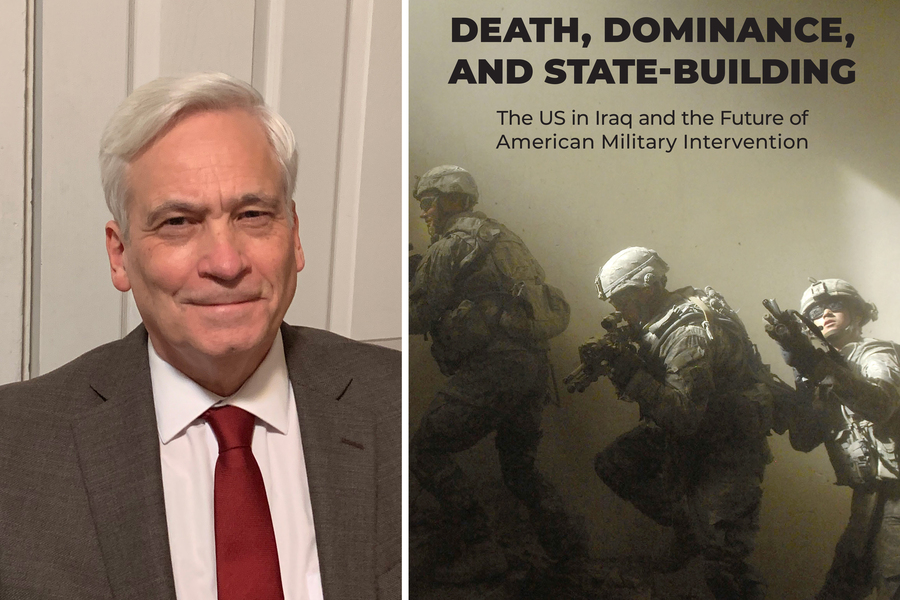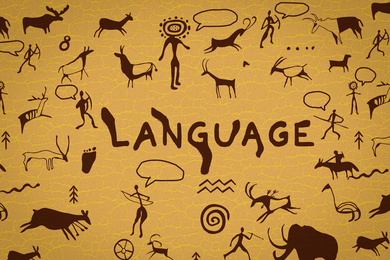The term “fog of war” expresses the chaos and uncertainty of the battlefield. Often, it is only in hindsight that people can grasp what was unfolding around them.
Now, additional clarity about the Iraq War has arrived in the form of a new book by MIT political scientist Roger Petersen, which dives into the war’s battlefield operations, political dynamics, and long-term impact. The U.S. launched the Iraq War in 2003 and formally wrapped it up in 2011, but Petersen analyzes the situation in Iraq through the current day and considers what the future holds for the country.
After a decade of research, Petersen identifies four key factors for understanding Iraq’s situation. First, the U.S. invasion created chaos and a lack of clarity in terms of the hierarchy among Shia, Sunni, and Kurdish groups. Second, given these conditions, organizations that comprised a mix of militias, political groups, and religious groups came to the fore and captured elements of the new state the U.S. was attempting to set up. Third, by about 2018, the Shia groups became dominant, establishing a hierarchy, and along with that dominance, sectarian violence has fallen. Finally, the hybrid organizations established many years ago are now highly integrated into the Iraqi state.
Petersen has also come to believe two things about the Iraq War are not fully appreciated. One is how widely U.S. strategy varied over time in response to shifting circumstances.
“This was not one war,” says Petersen. “This was many different wars going on. We had at least five strategies on the U.S. side.”
And while the expressed goal of many U.S. officials was to build a functioning democracy in Iraq, the intense factionalism of Iraqi society led to further military struggles, between and among religious and ethnic groups. Thus, U.S. military strategy shifted as this multisided conflict evolved.
“What really happened in Iraq, and the thing the United States and Westerners did not understand at first, is how much this would become a struggle for dominance among Shias, Sunnis, and Kurds,” says Petersen. “The United States thought they would build a state, and the state would push down and penetrate society. But it was society that created militias and captured the state.”
Attempts to construct a well-functioning state, in Iraq or elsewhere must confront this factor, Petersen adds. “Most people think in terms of groups. They think in terms of group hierarchies, and they’re motivated when they believe their own group is not in a proper space in the hierarchy. This is this emotion of resentment. I think this is just human nature.”
Petersen’s book, “Death, Dominance, and State-Building: The U.S. in Iraq and the Future of American Military Intervention,” is published today by Oxford University Press. Petersen is the Arthur and Ruth Sloan Professor of Political Science at MIT and a member of the Security Studies Program based at MIT’s Center for International Studies.
Research on the ground
Petersen spent years interviewing people who were on the ground in Iraq during the war, from U.S. military personnel to former insurgents to regular Iraqi citizens, while extensively analyzing data about the conflict.
“I didn’t really come to conclusions about Iraq until six or seven years of applying this method,” he says.
Ultimately, one core fact about the country heavily influenced the trajectory of the war. Iraq’s Sunni Muslims made up about 20 percent or less of the country’s population but had been politically dominant before the U.S. took military action. After the U.S. toppled former dictator Saddam Hussein, it created an opening for the Shia majority to grasp more power.
“The United States said, ‘We’re going to have democracy and think in individual terms,’ but this is not the way it played out,” Petersen says. “The way it played out was, over the years, the Shia organizations became the dominant force. The Sunnis and Kurds are now basically subordinate within this Shia-dominated state. The Shias also had advantages in organizing violence over the Sunnis, and they’re the majority. They were going to win.”
As Petersen details in the book, a central unit of power became the political militia, based on ethnic and religious identification. One Shia militia, the Badr Organization, had trained professionally for years in Iran. The local Iraqi leader Moqtada al-Sadr could recruit Shia fighters from among the 2 million people living in the Sadr City slum. And no political militia wanted to back a strong multiethnic government.
“They liked this weaker state,” Petersen says. “The United States wanted to build a new Iraqi state, but what we did was create a situation where multiple and large Shia militia make deals with each other.”
A captain’s war
In turn, these dynamics meant the U.S. had to shift military strategies numerous times, occasionally in high-profile ways. The five strategies Petersen identifies are clear, hold, build (CHB); decapitation; community mobilization; homogenization; and war-fighting.
“The war from the U.S. side was highly decentralized,” Petersen says. Military captains, who typically command about 140 to 150 soldiers, had fairly wide berth in terms of how they were choosing to fight.
“It was a captain’s war in a lot of ways,” Petersen adds.
The point is emphatically driven home in one chapter, “Captain Wright goes to Baghdad,” co-authored with Col. Timothy Wright PhD ’18, who wrote his MIT political science dissertation based on his experience and company command during the surge period.
As Petersen also notes, drawing on government data, the U.S. also managed to suppress violence fairly effectively at times, particularly before 2006 and after 2008. “The professional soldiers tried to do a good job, but some of the problems they weren’t going to solve,” Petersen says.
Still, all of this raises a conundrum. If trying to start a new state in Iraq was always likely to lead to an increase in Shia power, is there really much the U.S. could have done differently?
“That’s a million-dollar question,” Petersen says.
Perhaps the best way to engage with it, Petersen notes, is to recognize the importance of studying how factional groups grasp power through use of violence, and how that emerges in society. It is a key issue running throughout Petersen’s work, and one, he notes, that has often been studied by his graduate students in MIT’s Security Studies Program.
“Death, Dominance, and State-Building” has received praise from foreign-policy scholars. Paul Staniland, a political scientist at the University of Chicago, has said the work combines “intellectual creativity with careful attention to on-the ground dynamics,” and is “a fascinating macro-level account of the politics of group competition in Iraq. This book is required reading for anyone interested in civil war, U.S. foreign policy, or the politics of violent state-building."
Petersen, for his part, allows that he was pleased when one marine who served in Iraq read the manuscript in advance and found it interesting.
“He said, ‘This is good, and it’s not the way we think about it,’” Petersen says. “That’s my biggest compliment, to have a practitioner say it make them think. If I can get that kind of reaction, I’ll be pleased.”






